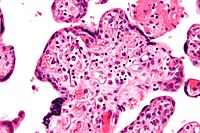
Photo from wikipedia
BackgroundFetal growth has been known to be associated with particulate matter (PM) air pollution during gestation. Given that regular working may deviate outdoor air pollution exposure, the association between air… Click to show full abstract
BackgroundFetal growth has been known to be associated with particulate matter (PM) air pollution during gestation. Given that regular working may deviate outdoor air pollution exposure, the association between air pollution and fetal growth restriction can be different across maternal working status. This study was to assess possible effect modification by maternal employment in the association between exposure to PM during pregnancy and fetal growth restriction.MethodsUsing hourly PM less than or equal to 10 and 2.5 μm in diameter (PM10 and PM2.5) regulatory monitoring data for 2001–2012 and 2008–2012, respectively, and birth certificate data for 2002–2012, we computed maternal exposures with district-level averages of PM10 and PM2.5 during one year before birth, entire pregnancy, and the 1st, 2nd and 3rd trimesters. The outcomes of fetal growth restriction were assessed by small for gestational age (SGA, weighted <10th percentile in the same gestational age) as well as low birth weight (LBW, < 2.5 kg) at term. We performed logistic regression to examine the association between PM and each of fetal growth restriction outcomes adjusting for individual risk factors. For effect modification by maternal employment, we estimated adjusted odds ratio (OR) of SGA or LBW for interquartile (IQR) increases in PM10 or PM2.5 stratified by employed and non-employed mothers. We also computed relative excess risk due to interaction (RERI) to investigate additive interaction.ResultsAmong 824,011 singleton term births, 34.0% (279,856) were employed and 66.0% (544,155) were non-employed mothers. Proportions of LBW were 1.5% in employed and 1.6% in non-employed (P < 0.001). SGA occurred in 12.7% of employed and 12.8% of non- employed (P = 0.124) mothers. For non-employed mothers, we observed increased odds of SGA per IQR increase in PM10 for one year before birth (OR = 1.02, 95% confidence intervals (CI): 1.00–1.04, P = 0.028). ORs of SGA for full pregnancy period and the 3rd trimester were also positive but did not reach statistical significance. We did not observe positive association for PM2.5. RERI was not significant both for PM10 and PM2.5.ConclusionsWe did not observe evidence of effect modification by maternal employment in the association between ambient PM and fetal growth restriction. Future studies using more refined exposure measures should confirm this finding.
Journal Title: BMC Pregnancy and Childbirth
Year Published: 2019
Link to full text (if available)
Share on Social Media: Sign Up to like & get
recommendations!